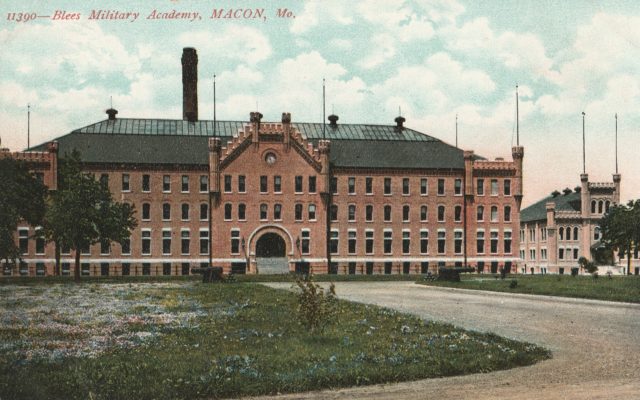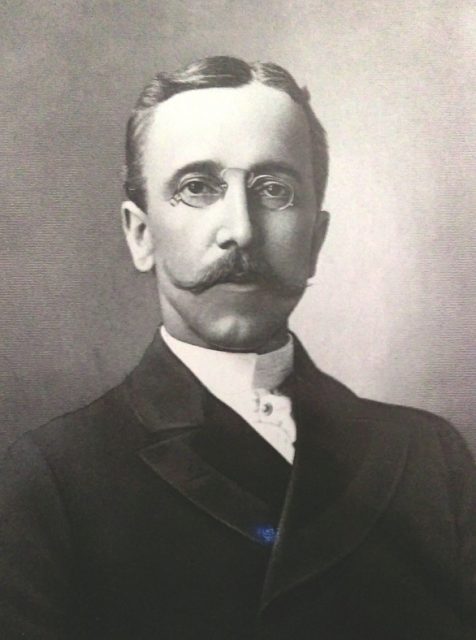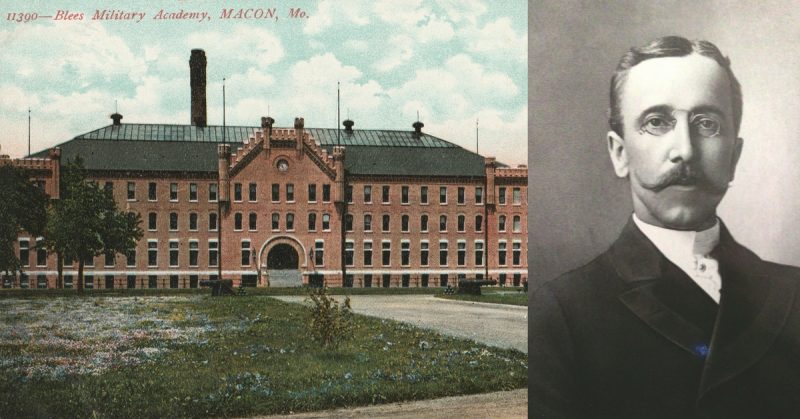War History online proudly presents this Guest Piece from Jeremy P. Ämick, who is a military historian and writes on behalf of the Silver Star Families of America.
For more information on the Macon County Historical Society and Museum, please visit http://www.maconcountyhistoricalsociety.com
When traveling north along U.S. 63, motorists pass by a massive complex just south of Macon, Mo., that was constructed more than a century ago and is described in the inventory of the National Register of Historic Places as a “variant of the Romanesque Revival style.” Once home to a renowned military academy, the remaining structures on the property serve as an enduring testament to the lofty dreams of its namesake, Frederick Wilhelm Victor Blees.
“Colonel Blees was born in Prussia (now Germany) in 1860, said Mardine White, a volunteer with the Macon County Historial Society. “
As White explained, Blees was well educated and became a second lieutenant in the Prussian Army but then moved to the United States in 1881, becoming a naturalized citizen later the same year. While working as a teacher, he met and married Mary Virginia Staples in 1886.
The former German officer received his first exposure to the structure of American military academies when he was appointed as commandant of cadets at Griswold College in Davenport, Iowa, in 1890.While in Iowa, Blees progressed through the military ranks after joining the Iowa National Guard, and, as noted in the 1891 Report of the Adjutant-General to the Governor of Iowa, was appointed a lieutenant colonel by Gov. Horace Boies.
Attaining the rank of colonel, in 1892 he accepted headmastership of St. James Military Academy at Macon, Mo., which, as his obituary shows, “he conducted with marked success, making it one of the flourishing institutions in the state.”

An article in the September 15, 1906 edition of The Macon Republican explained that following the death of his father in 1896, Blees closed the St. James Military Academy and returned to Germany, promising the citizens of Macon, “When matters across the water are straightened out, I’ll return and build you the finest military academy in the west.”
Blees inherited an estate worth millions from his father and returned to Macon, quickly using his newfound fortunes to not only fulfill a promise, but to help advance the community he now called home.
“Colonel Blees helped fund several public projects such as the construction of sewer systems and paving of streets in Macon,” said White, recalling some of the research conducted on Blees’ life by the local historical society.
At a well-attended ceremony held on June 17, 1899, the cornerstone was laid for the new Blees Military Academy. During the ceremony, a copper box was placed inside the cornerstone containing a copy of the program for the exercises, copies of local newspapers, an old St. James Bible and prayer book in addition to photographs of Blees, his family and those associated with the dedication and construction of the academy.
The academy initially consisted of a large brick academic hall (measuring 224 feet long by 88 feet wide) and an adjacent heating facility. A smaller annex building situated to the right of the academic hall was built in 1900, serving as the school’s gymnasium and containing an indoor running track, shooting gallery and swimming pool.
“I’ve heard claims that the building (the academic hall) went up in seven months; it was worked on 24 hours a day, seven days a week,” said White. “Another interesting thing about the building,” she added, “is that it was essentially fireproof …even his desk was made of metal.”

Newspaper and historical accounts paint a picture of a school that soon acquired a superb reputation throughout the Midwest; however, the training of young men in academics and a military lifestyle did not remain the sole focus of Blees’ efforts since he also chose to pursue certain entrepreneurial endeavors.
According to the Macon County Historical Society, Blees helped establish many enterprises such as the Macon Shear Company, Macon Citizen Printing Company, Jefferson Hotel, Blees Theater and the Blees-McVicker Carriage Company. He also purchased the first electric automobile made by Studebaker in 1902. (The second such vehicle was purchased by inventor Thomas Edison.)
Despite any appearances of budding success, it was only a few years later that the storied life of one of Macon’s most renowned citizens plummeted to an untimely closing. On September 8, 1906, Blees died from heart disease in a hotel room while on a trip to St. Louis. His body was returned to Macon and buried in Oakwood Cemetery.
“The death of Col. Blees will not interfere in any way with the operations of the institutions in which he has been connected,” noted The Macon Times-Democrat on September 13, 1908. “The Blees Military Academy will open on Wednesday, September 19, and will have its usual quota of students.”
The academy continued to operate under the guidance of Blees’ widow for three years until eventually going bankrupt, thus necessitating its closing in 1909. The property sat vacant until 1915, when it was purchased for the Still-Hildreth Osteopathic Sanatorium, which remained in operation until 1968.
The academic hall underwent renovation in the 1980s and is now a senior residential facility. For many years, the building housing the academy’s gymnasium was used as an armory by the National Guard but has since become the museum and home for the Macon County Historical Society.
More than a century now separates the people of Macon from the life of a fascinating man who clung to lofty dreams and visions, but the legacy Blees left behind is neither trivial nor forgotten; instead, it bursts forth with renewed vigor thanks to the dedication of a small group of volunteers.
“Blees is certainly a large part our county’s history,” said White. “Our historical society—which is run entirely by volunteers—enjoys being able to share the story of his life with others.” She added, “And if you can get through to one or two young minds, to share with them the impact and influence of citizens such as Blees, then everything that we do here is certainly worth the effort.”
